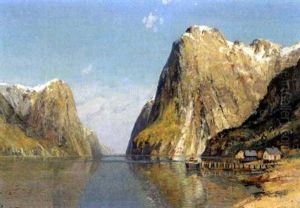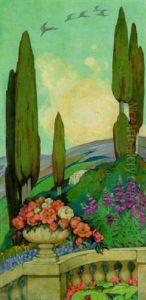Florence Lundborg Paintings
Florence Lundborg was an American painter born on March 14, 1871, in San Francisco, California. Lundborg was known for her versatility as an artist, working in different styles and mediums including oil painting, watercolor, and mural painting. Her work often reflected the transition from the 19th-century academic tradition to the modernist approaches of the early 20th century.
Florence Lundborg studied at the California School of Design in San Francisco, where she was influenced by her instructors Arthur Mathews and Amedee Joullin, both of whom were prominent figures in the California art scene. In 1895, she traveled to Paris to continue her education at the Académie Colarossi, one of the progressive art schools open to both women and men. While in Paris, she was exposed to the avant-garde movements of the time and began incorporating elements of Impressionism and Post-Impressionism into her work.
Upon returning to the United States, Lundborg settled in New York City where she became part of the vibrant art community and participated in various exhibitions. Her work was exhibited at the National Academy of Design, the Pennsylvania Academy of the Fine Arts, and the Art Institute of Chicago, among other institutions. Lundborg also became a member of the National Association of Women Painters and Sculptors, an organization that promoted the work of female artists.
In the early 20th century, Lundborg was involved in mural painting, a popular art form during the period, especially in the context of public and institutional commissions. Her murals can be found in several locations, including the Appellate Court in New York and other civic buildings. Her compositions were often allegorical, featuring classical figures and motifs, which were typical of the Beaux-Arts architectural style prevalent at the time.
Throughout her career, Lundborg continued to experiment with different subjects and styles. She painted portraits, landscapes, and allegorical works, demonstrating a commitment to exploring the formal and thematic possibilities of art. Her paintings were known for their lyrical quality and sensitivity to color and light.
Florence Lundborg passed away on December 31, 1949, in San Francisco, leaving behind a diverse body of work that contributes to our understanding of American art in the transition from the 19th to the 20th century. Her legacy is preserved through her paintings, which continue to be appreciated for their historical significance and artistic merit.



